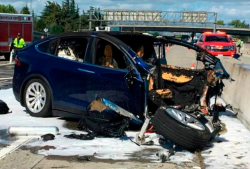
— The National Transportation Safety Board (NTSB) has released its preliminary report about a Tesla crash that occurred on March 23, 2018, when 38-year-old Wei Huang was driving his 2017 Model X on Highway 101 in Mountain View, California.
According to officials, the SUV was traveling with Autopilot engaged, specifically Traffic-Aware Cruise Control and lane-keeping technology called Autosteer.
According to Tesla, the cruise control feature should allow a set speed and a set following distance behind a vehicle in front of the SUV.
The Model X slammed into a "crash attenuator," a device used to absorb the kinetic energy of a crash, although in this case the attenuator had been damaged from a previous crash.
Data from the vehicle shows Autopilot was activated four times during the 32-minute trip, including the entire last 18 minutes and 55 seconds before the crash. The SUV warned the driver with two visual alerts and one audible alert to put his hands on the steering wheel, but the alerts were made 15 minutes prior to the crash.
With Autopilot engaged, cruise control set at 75 mph and 8 seconds before impact, the Tesla was following another vehicle and traveling about 65 mph. But 7 seconds before the crash the SUV started moving to the left even though the vehicle in front didn't, and 4 seconds prior to the crash the Model X was no longer following the lead vehicle.
Investigators further say the data shows the SUV increased its speed from 62 to nearly 71 mph about 3 seconds before the crash. Although Autopilot was engaged, the SUV took no evasive action to avoid the barrier, and neither did the driver.
According to the NTSB, the driver placed his hands on the steering wheel three different times within 60 seconds before the crash, but not during the final 6 seconds before the crash.
The impact caused the Model X to turn counterclockwise and obliterated the front-end of the SUV. In addition, the Tesla was involved in subsequent collisions with a 2010 Mazda 3 and a 2017 Audi A4.
The severe impact also caused the 400-volt lithium-ion high-voltage battery to catch fire and although bystanders were able to remove the driver before the fire took over, Mr. Huang was pronounced dead at the hospital.
The Mountain View Fire Department used about 200 gallons of water and foam in less than 10 minutes to extinguish fires involving the vehicle interior and the exposed portion of the lithium-ion battery.
Experts from Tesla were called to advise first responders about the dangers associated with the high-voltage battery and the SUV was eventually escorted by fire truck to an impound lot in San Mateo. California officials say it took nearly six hours before the highway was finally reopened to traffic.
The NTSB says it opened the investigation not only because Autopilot was engaged, but also to learn more about post-crash battery fires that will become more common as more vehicles run on electricity alone.
Once the Model X was transported to the lot, the battery started smoking and personnel could hear a venting sound, so the battery was monitored with a thermal imaging camera.
Five days after the crash, the battery caught fire again and this time the San Mateo Fire Department responded to put out the fire.
Federal safety investigators emphasize this is only a preliminary report and it could be months before a probable cause of the crash is released.




